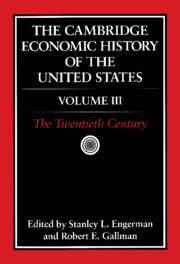Book contents
- Frontmatter
- 1 American Macroeconomic Growth in the Era of Knowledge-Based Progress: The Long-Run Perspective
- 2 Structural Changes: Regional and Urban
- 3 Twentieth-Century Canadian Economic History
- 4 The Twentieth-Century Record of Inequality and Poverty in the United States
- 5 The Great Depression
- 6 War and the American Economy in the Twentieth Century
- 7 U.S. Foreign Trade and Trade Policy in the Twentieth Century
- 8 U.S. Foreign Financial Relations in the Twentieth Century
- 9 Twentieth-Century American Population Growth
- 10 Labor Markets in the Twentieth Century
- 11 Labor Law
- 12 The Transformation of Northern Agriculture, 1910–1990
- 13 Banking and Finance in the Twentieth Century
- 14 Twentieth-Century Technological Change
- 15 The U.S. Corporate Economy in the Twentieth Century
- 16 Government Regulation of Business
- 17 The Public Sector
- Bibliographic Essays
- Index
- References
11 - Labor Law
Published online by Cambridge University Press: 28 March 2008
- Frontmatter
- 1 American Macroeconomic Growth in the Era of Knowledge-Based Progress: The Long-Run Perspective
- 2 Structural Changes: Regional and Urban
- 3 Twentieth-Century Canadian Economic History
- 4 The Twentieth-Century Record of Inequality and Poverty in the United States
- 5 The Great Depression
- 6 War and the American Economy in the Twentieth Century
- 7 U.S. Foreign Trade and Trade Policy in the Twentieth Century
- 8 U.S. Foreign Financial Relations in the Twentieth Century
- 9 Twentieth-Century American Population Growth
- 10 Labor Markets in the Twentieth Century
- 11 Labor Law
- 12 The Transformation of Northern Agriculture, 1910–1990
- 13 Banking and Finance in the Twentieth Century
- 14 Twentieth-Century Technological Change
- 15 The U.S. Corporate Economy in the Twentieth Century
- 16 Government Regulation of Business
- 17 The Public Sector
- Bibliographic Essays
- Index
- References
Summary
INTRODUCTION: WHAT IS LABOR LAW? WHAT IS ITS HISTORY?
Labor historians focus on the relations over time between employers and employees. Traditionally they have treated these relations as between two irreducibly collective social phenomena – capital and labor. Unsurprisingly, then, when it has come to writing the history of labor law, what has emerged is largely a history of the law that has impacted most upon the relations of capital and labor as organized interests, the law of collective bargaining and its antecedents. When, for example, a quarter century ago, Dean Harry Wellington of Yale Law School chose the beginning of the nineteenth century as the most appropriate point of departure for his study Labor and the Legal Process, he explained that he wanted to “begin at the beginning of American labor law,” and he defined that beginning as the moment in American history when journeymen’s combinations began to be prosecuted as common law conspiracies in American courts.
Chronologically, as we shall see, Wellington’s point of departure does in fact have much to recommend it. In addition, understanding the history of the law of collective organization and bargaining remains of the first importance to understanding the historical relationship between law and labor overall. But that story is not the full story. In particular, it is a mistake to treat the law of collective activity in isolation from the legal history of the individual employment relationship. Here, then, we will situate the history of collective bargaining in the context of the history of the law of individual labor, the “law of master and servant.”
- Type
- Chapter
- Information
- The Cambridge Economic History of the United States , pp. 625 - 692Publisher: Cambridge University PressPrint publication year: 2000
References
- 1
- Cited by



